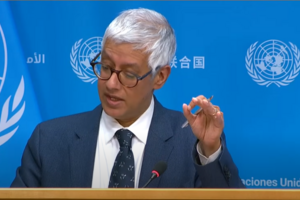Why Andrew Yang’s Forward Party Might be our Best Option

Editor's Note: The author of this article is a registered volunteer for the Forward Party. She does not represent the official views of the Forward Party. Get all sides of this topic by reading another view: To Give a Voice to the Political Center, Andrew Yang’s Forward Party Must Prove It Can Win
A new political party, the Forward Party, has emerged on the political scene.
Originally created by Andrew Yang, who was a 2020 presidential candidate, The Forward Party recently merged with the Save America Movement (SAM) and the Renew America Movement (RAM), making it the third largest political party in America when measured by resources and staff, according to Will Conway, the National Organizing Director for Forward. With Forward's announcement also came waves of criticism– despite this, there are reasons to believe Forward is both a viable and worthwhile option for Americans.
The most prominent concern from Forward critics is that third parties have never worked in the past, so why would Forward be any different? But according to Gallup (Center bias), 62% of Americans wanted a third party in 2021. That’s the highest recorded support percentage for third parties in American history.
However, even if Americans want a third party, there is a ballot access issue. That’s where the Forward Party policies come in.
One of their policies is that anyone can be a Forwardist without giving up party affiliation. According to their website (before it was updated in the merger with RAM and SAM), “Due to the current electoral process, in the vast majority of races the Forward Party will be involved in, the candidate is likely to be running as a member of one of the major parties.” If the candidate decided they wanted to keep their previous party affiliation it would squash some of the critiques about the spoiler effect, which is a term used to describe the argument that “voting third party is actually helping the other side win.”
Why should a Democrat vote for a Forward Republican or vice versa? Well, not all Democrats will, and that's okay. Forward’s principles are about putting country over party. Forward wants to put citizens in office who value a functional democracy and wants to revive the idea that reasonable people can disagree. If someone can’t stomach the thought that someone from the opposing party can be a good and reasonable elected official and examine them on individual merits, then the Forward Party probably isn’t for them.
The second way that Forward can fix its ballot access issue is through championing a Final Four voting system, also referred to as Ranked Choice Voting (RCV) or instant-runoff voting, coupled with open (non-partisan) primaries. This Final Four voting system would allow third parties to be more successful than in the past because of its methodology. Alaska has already implemented the Final Four system, proving that it has the potential to be implemented nationwide.
There are two ways that Ranked Choice Voting (RCV) reduces political polarization, in theory. The most obvious is giving voters more choice by eliminating the spoiler effect. Ranked Choice Voting enables voters to vote for their favorite candidate even if they are from a third party because if their candidate has the least votes, their vote will then be moved to their second choice candidate, thereby eliminating the idea that someone is a “spoiler” but not voting for one of the major two parties.
The second way RCV can reduce polarization and toxicity in politics is because candidates are effectively fighting to be everyone’s second choice. It’s in the candidates’ interest to be well-liked to be higher up on the voters’ ranking, so they have to stand for something rather than just trashing their political opponents.
Some may argue that this has been tried to little avail. RCV is in place in New York City, and in the 2021, mayoral Democratic primary Andrew Yang teamed up with Kathryn Garcia in a campaign to get their voters to vote for Garcia as their second choice if they were a Yang voter, or Yang as their second choice if they were a Garcia voter — yet they still were unable to defeat Eric Adams.
Early on Yang was the primary favorite, but by June he had fallen to fourth in the polls, behind Adams, Garcia, and Wiley. With Garcia solidly in second place, it seems like the support of the “Yang Gang'' should have pushed her to the win.
Indeed, looking at the results of the primary, Yang had 14.8% of the vote when he was eliminated from the nominee pool (Round 6) and if all of those votes were redirected to Garcia it would have boosted her to 39.1% of the vote, nearly matching Eric Adams 40.5%. In reality, Garcia only garnered 30.5% in Round 7, a 5.6% boost from the last round. RCV will never exist in a vacuum. It’s possible that many in NYC really liked Eric Adams, or didn’t want to vote for Garcia.
This isn’t a failure of RCV, though some may point to it as such if they haven’t examined the data (it does seem like the support for the second and fourth place candidates should overcome the first place candidate), but pairing RCV with open primaries could have a much greater effect.
The two-party system has immense control over who is allowed into primaries and how well they fare. In counties that are deeply red or blue (most people now live in these landslide counties), the election has effectively been decided before they even cast their vote.
A recent example of this system working is in Lisa Murkowski’s primary (R-AK). She moved on to the general election, along with three other candidates, even though she has been an outspoken critic of Donald Trump. Cheney (R-WY), who has similarly critiqued Trump, was ousted in her party’s primary, and pollster Ivan Moore told the Associated Press (Lean Left bias) that in a closed primary Murkowski “would have had a zero percent — I mean zero percent — chance of winning.” Without the purity tests of the Republican Party, and their loyalty to Trump, Alaskans were free to choose who they felt represented them best, and for some, that was Senator Murkowski.
In the Final Four voting system, the top four candidates from the general primary move on. That means in blue counties, like New York County, there may be four Democrats, or three Democrats and an Independent based on the voters' choice. So ideally this new voting system will give Independents and third parties a shot at representing the people in a way they have historically been prevented from serving.
Americans appear to be receptive to RCV, so why not have a non-profit, or a coalition? Why a political party?
I asked this question to Andrew Yang myself at a Braver Angels event earlier this year. He said something to the effect of, “We have tried the carrot, making the case for voting reform through organizations, and it hasn’t been very effective. Now we have to try the stick — we have to say, if you don’t change, I’m taking my vote elsewhere.”
There are organizations across the country dedicated to passing RCV, but they are fighting an uphill battle — elected officials in Tennessee and Florida have banned RCV. Sen. Brian Kelsey, who sponsored the ban in Tennessee, called it a victory for “election integrity and ensuring voter clarity.” The Final Four system doesn’t benefit those in office, and it doesn’t benefit the two party system; it benefits the people. So it makes sense that the people who got into office through the current system are not incentivized to change a system that works for them, but what about the Americans it isn’t working for?
This is why America needs a third party. It is, in effect, going straight to the people. If Forward gains enough support and momentum, even half of the 62% who wanted a third party in 2021, it will put pressure on the current politicians to adopt these policies or move out of the way so the voters can elect those who will. Putting pressure on politicians by saying, “I will not vote for you, I will vote for another party if you don’t support policies x, y, and z,” has a fundamentally different impact than a coalition or organization.
Once the ballot access problem has a proposed solution, people begin to express interest in the party and ask about all of the other issues they care about. What’s Forward’s stance on abortion and women’s rights? What about gun safety? Immigration?
The Forward Party doesn’t have an official stance on any of those issues. If American democracy isn't functioning, it becomes impossible to pass meaningful legislation on guns, immigration, or abortion. From a practical perspective, every time Forward locks itself into a specific policy position, it loses support from those who would disagree, and it needs every voter on board to be able to upend the structure of our electoral system.
On Forward's website, it says no purity tests, meaning there is no checklist of beliefs someone needs to have to call themselves a Forwardist if they believe in its mission of giving a voice to the exhausted majority. It also says it’s “a political home for everyone willing to set aside the partisan extremes.” By this, Forward does not mean check your core beliefs at the door. A better word might be to set aside toxic polarization. Bring questions, fierce opinions and debates, but don’t bring disgust and hatred for your fellow Americans.
Forward is looking to create a system in which the political incentives are to work across the aisle to pass legislation that helps Americans, rather than to cater to the most extreme parts of the voter blocs because they have the power in political primaries.
When Forward says they represent “centrists,” they mean a Congress and government with broad-ranging opinions hashed out through debate and old-fashioned compromise. The best policy solution won’t always be straight down the middle, nor do most voters want that. If Americans’ opinions are accurately represented, then policies will reflect the majority opinion of the people.
Before Forward can accomplish any of this, they must deal with the election reform issue in order to have a shot at being elected.
Others have argued that voters won’t trust a politician who only runs on election reform and a vague notion of unity. Voters understand that the politician will have to vote on various issues once elected, and voters need transparency about the candidate’s views on all issues that may arise.
The answer to this is that Forward politicians will have platforms with views on all of the controversial issues you can imagine, but their views may differ from candidate to candidate.
By keeping its stance on certain issues open, Forward is inviting traditional Democrats, Republicans, and others to join its ranks. Rather than the top-down approach traditional parties take, Forward believes that what works in one community may be different for another community. While a conservative Forwardist may not fare well in Orange County, California, they may be better equipped than a Democrat to understand what their local community in Nebraska needs, and vice versa.
The plan for Forward in the future is to allow local chapters to decide who to support as a Forward candidate on an individual basis — first focusing on getting candidates to run for local positions that are often uncontested, before moving up to national offices.
If Forward promotes healthy debate, diversity of thought, and local decisions, how will that work on the national level?
Some point to the states of the Democratic and Republican parties and say that the problem is grouping too many different types of people together. Take the Democrats, trying to appease moderates, liberals, and leftists all at once, and always leaving someone disappointed. On the Republican side, there are Evangelicals, libertarians, social and fiscal conservatives, populists, and the new right.
This issue occurs because of a lack of choice. Leftists, for example, are upset with how the moderate Democrat votes, but feel like they have to continue to vote for the Democratic candidate because it’s better, in their view, than giving a vote to Republicans. However, Final Four voting would allow said leftist to vote for a Democrat they actually align with first, a moderate Democrat second, and a Republican third.
One valid critique is that when people see an R or a D on the ballot, they know what general policies they are voting for. If they vote for someone who is a standalone Forwardist, it requires the voter to be educated on the individual candidate. It’s an unavoidable side effect of rejecting a one-size-fits-all approach and will require candidates to campaign and debate effectively so that everyone knows their values. But to reiterate, many candidates (as of now) may be running as Forward Democrats or Forward Republicans, which would solve that issue.
The Forward Party is less than a year old, and admittedly still figuring some things out through this substantial growth period.
One of those things is messaging. As a result of the Forward Party not always being clearly communicated, it’s easy for others to poke fun at it. They say it’s a nothingburger — a pipe dream in which everyone shares the same opinions and comes together singing kumbaya. These may be lazy depictions of what some pundits haven’t fully taken the time and research to understand, but others have taken the time to understand the goals of the party and even appreciate them, but remain skeptical of the project's success.
They may be right. Forward has no idea if this election reform and common sense approach will make a major difference in politics. Maybe Forward members are unbelievably naive to think they can take on this monumental task of changing America’s political system. However, as many Americans continue to complain about the system failing them, Forward is doing something to try to fix it.
Do you think the Forward Party will be successful? Share your thoughts with us at admin@allsides.com.
Clare Ashcraft is the Bridging & Bias Assistant at AllSides. She has Center bias.
This piece was reviewed by Henry A. Brechter, Managing Editor (Center bias), Julie Mastrine, Director of Marketing and Media Bias Ratings (Lean Right) and Joseph Ratliff, Daily News Editor (Lean Left).

May 21st, 2024


May 16th, 2024

May 16th, 2024